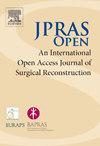An Optimal Scalp Rotation Flap Design: Mathematical and Bio-Mechanical Analysis
IF 1.5
Q3 SURGERY
引用次数: 0
Abstract
The design and implementation of successful rotational flaps of the scalp remains a complex process. There are several described techniques, all of which are based on a two-dimension surface, absent consideration of the convexity, and thereby three-dimensional nature of the scalp. This has contributed to flaps that are either too small or unnecessarily large in a bid to compensate. Mathematical analysis using trigonometric and algebraic formulas was used to derive the relationship between the defect, triangulation, the contour of the scalp, the radius of the arc of rotation for the flap, and scalp skin tension. Polyurethane models were used to test the applicability of the resultant formula, and a consecutive clinical case series is presented. Rotation flap dimensions were calculated using an apex angle of 30° depicted as a two-dimensional construct. The contour of the defect was then measured as the depth of depression with radius of the rotation flap calculated based on the changes in flap surface area across the defect. Finite element analysis was used to measure redistribution of tension along the flap reconstructing the defect, and the efficacy of the approach was confirmed in the consecutive clinical series. This study provides a reliable flap design based on mathematical analysis, with evidence-based application to the clinical setting.
最佳头皮旋转瓣设计:数学与生物力学分析。
成功的头皮旋转皮瓣的设计和实施仍然是一个复杂的过程。有几种描述的技术,所有这些技术都是基于二维表面,没有考虑到头皮的凹凸性,因此头皮的三维性质。这导致襟翼要么太小,要么太大,以弥补。利用三角函数和代数公式进行数学分析,推导出缺损、三角剖分、头皮轮廓、皮瓣旋转弧半径和头皮皮肤张力之间的关系。使用聚氨酯模型来测试所得公式的适用性,并提出了连续的临床病例系列。旋转皮瓣的尺寸计算使用顶点角30°描绘为二维结构。然后测量缺陷的轮廓作为凹陷深度,根据皮瓣表面积的变化计算出旋转皮瓣的半径。采用有限元分析测量沿皮瓣重建缺损的张力再分布,并在连续的临床系列中证实了该方法的有效性。本研究提供了一种基于数学分析的可靠皮瓣设计,并以证据为基础应用于临床。
本文章由计算机程序翻译,如有差异,请以英文原文为准。
求助全文
约1分钟内获得全文
求助全文
来源期刊

JPRAS Open
Medicine-Surgery
CiteScore
1.60
自引率
0.00%
发文量
89
审稿时长
22 weeks
期刊介绍:
JPRAS Open is an international, open access journal dedicated to publishing case reports, short communications, and full-length articles. JPRAS Open will provide the most current source of information and references in plastic, reconstructive & aesthetic surgery. The Journal is based on the continued need to improve surgical care by providing highlights in general reconstructive surgery; cleft lip, palate and craniofacial surgery; head and neck surgery; skin cancer; breast surgery; hand surgery; lower limb trauma; burns; and aesthetic surgery. The Journal will provide authors with fast publication times.
 求助内容:
求助内容: 应助结果提醒方式:
应助结果提醒方式:


